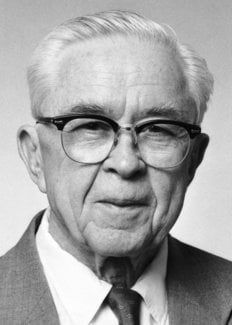Edward B. Lewis
Biographical

Dr. Lewis received the B.A. degree from the University of Minnesota in 1939 and the Ph.D. from the California Institute of Technology in 1942. He served to the rank of captain in the United States Army Air Force from 1942-1945 as a meteorologist and oceanographer in the Pacific Theater. He joined the Caltech faculty in 1946 as an instructor. In 1956 he was appointed Professor of Biology and in 1966 Thomas Hunt Morgan Professor of Biology. He was a Rockefeller Foundation Fellow at Cambridge University, England (1947-48) and Guest Professor at the Institute of Genetics, University of Copenhagen, Denmark (1975-76).
He is a member of the National Academy of Sciences, the Genetics Society of America, the American Philosophical Society, and the American Academy of Arts and Sciences. He is a foreign member of the Royal Society (London) and an honorary member of the Genetical Society of Great Britain. He is a recipient of the Thomas Hunt Morgan Medal (1983), the Gairdner Foundation International award (1987), the Wolf Foundation prize in medicine (1989), the Rosenstiel award (1990), the National Medal of Science (1990), the Albert Lasker Basic Medical Research Award (1991), and the Louisa Gross Horwitz prize (1992). He holds honorary degrees from the University of Umeå, Umeå, Sweden (1981) and the University of Minnesota (1993).
Dr. Lewis and his wife, Pamela, an artist, have three children: Hugh, an attorney who lives in Bellingham, Washington, Glenn (deceased) and Keith, a biology research assistant who lives in Berkeley, California.
| Principal works of Edward B. Lewis | |
| 1950 | Lewis, E. B. The phenomenon of position effect. Advances in Genetics 3: 73-115. |
| 1951 | Lewis, E. B. Pseudoallelism and gene evolution. Cold Spring Harbor Symposia on Quantitative Biology 16: 159-174. |
| 1964 | Lewis, E. B. Genetic control and regulation of developmental pathways. Role of Chromosomes in Development, pp. 231-252. Edited by M. Locke. Adacemic Press, New York. |
| 1968 | Lewis, E. B. Genes and gene complexes. Heritage from Mendel, pp. 17-47. Edited by R. A. Brink. University of Wisconsin Press, Madison, Wisconsin. |
| 1976 | Garcia-Bellido, A. and Lewis, E. B. Autonomous cellular differentiation of homoeotic bithorax mutants of Drosophila melanogaster. Develop. Biol. 48: 400-410. |
| 1978 | Lewis, E. B. A gene complex controlling segmentation in Drosophila. Nature 276: 565-570. |
| 1982 | Duncan, Ian and Lewis, E. B. Genetic control of body segment differentiation in Drosophila. In Developmental Order: Its Origin and Regulation. 40th Annual Symposium of the Society for Developmental Biology, Boulder, Colorado, June 1981. Edited by S. Subtelny and P. B. Green. Alan R. Liss, Inc., New York, 1982, pp. 533-554. |
| 1982 | Lewis, E. B. Control of body segment differentiation in Drosophila by the bithorax gene complex. In Embryonic Development, Part A: Genetic Aspects. Edited by M. M. Burger and R. Weber. Alan R. Liss, New York., pp. 269-288. |
| 1983 | Bender, W., Akam, M., Karch, F, Beachy, P. A., Peifer, M., Spierer, P., Lewis, E. B. and Hogness, D. S. Molecular genetics of the bithorax complex in Drosophila melanogaster. Science 221: 23-29. |
| 1985 | Karch, F, Weiffenbach, B., Peifer, M., Bender, W., Duncan, I., Celniker, S., Crosby, M. and Lewis, E. B. The abdominal region of the bithorax complex. Cell 43: 81-96. |
| 1986 | Lewis, E. B. Regulation of the genes of the bithorax complex in Drosophila. Cold Spring Harbor Symposia on Quantitative Biology, 50: 155-164. |
| 1987 | Celniker, S. E. and Lewis, E. B. Transabdominal, a dominant mutant of the Bithorax Complex, produces sexually dimorphic segmental transformation of Drosophila. Genes and Development 1: 111-123. |
| 1989 | Celniker, S. E., Keelan, D. and Lewis, E. B. The molecular genetics of the Bithorax Complex of Drosophila: Characterization of the products of the Abdominal-B domain. Genes and Development 3: 1424-1435. |
| 1990 | Celniker, S. E., Sharma, S., Keelan, D. and Lewis, E. B. The molecular genetics of the bithorax complex of Drosophila: cis-regulation in the Abdominal-B domain. EMBO J. 9: 4277-4286. |
| 1992 | Lewis, E. B. Clusters of master control genes regulate the development of higher organisms. The 1991 Albert Lasker Medical Awards. JAMA 267:1524-1531. |
| 1993 | Celniker, S. E. and Lewis, E. B. Molecular basis of Transabdominal-a novel sexually dimorphic mutant of the bithorax complex of Drosophila. Proc. Natl. Acad. Sci. 90: 1566-1570. |
| 1994 | Fernandes, J., Celniker, S. E., Lewis, E. B. and VijayRaghavan, K. Muscle development in the four-winged Drosophila and the role of the Ultrabithorax gene. Current Biology 4: 957-964. |
| 1995 | Martin, C. H., Mayeda, C. A., Davis, C. A., Ericsson, C. L., Knafels, J. D., Mathog, D. R., Celniker, S. E., Lewis, E. B. and Palazzolo, M.J. Complete sequence of the bithorax complex of Drosophila. Proc. Natl. Acad. Sci. 92: 8398-8402. |
| 1995 | Lewis, E. B., Knafels, J. D., Mathog, D. R. and Celniker, S. E. Sequence analysis of the cis-regulatory regions of the bithorax complex of Drosophila. Proc. Natl. Acad. Sci. 92: 8403-8407. |
This autobiography/biography was written at the time of the award and later published in the book series Les Prix Nobel/ Nobel Lectures/The Nobel Prizes. The information is sometimes updated with an addendum submitted by the Laureate.
Edward B. Lewis died on July 21, 2004.
Nobel Prizes and laureates
Six prizes were awarded for achievements that have conferred the greatest benefit to humankind. The 14 laureates' work and discoveries range from quantum tunnelling to promoting democratic rights.
See them all presented here.
